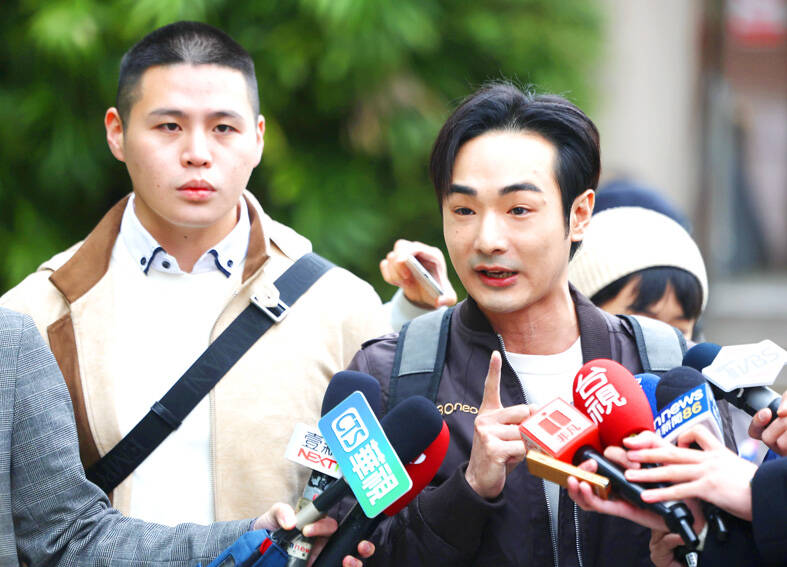The primary goal of responding to China’s “united front” propaganda on social media should be to expose intermediaries so they face public scrutiny, Democratic Progressive Party Legislator Puma Shen (沈伯洋) said.
The statement came in response to Taiwanese rapper Chen Po-yuan (陳柏源) exposing methods the Chinese Communist Party (CCP) uses to bribe Taiwanese influencers to promote its propaganda in a video produced by YouTuber “Pa Chiung (八炯)” that was published online on Friday.
Commenting on the matter, Shen on Saturday said the government should establish mechanisms to respond to online propaganda, so the public can report influencers’ “united front” activities.

Photo: CNA
This would increase public awareness and reduce the harm caused by influencers’ propaganda, he said.
Regulations imposed by tracking cash flow to influencers could be quickly circumvented, Shen said.
China could instead use virtual currencies or underground exchanges between Chinese and international platforms to avoid detection, he said.
For example, influencers could create pro-China videos on YouTube while “selling products” on Douyin, he said. While the cash flow should be investigated, the primary goal should be to identify “united front” intermediaries, including travel agencies, gangsters, academics, businesspeople and even legislators and public servants, he said.
Without these intermediaries, it would be much harder for China to engage with Taiwan’s public, he added.
China’s primary method of recruiting Taiwanese influencers is by attracting pro-China supporters to specific content and using Alipay or WeChat for donations, Kuma Academy chief executive officer and Taiwan National Security Institute deputy secretary-general Ho Cheng-hui (何澄輝) said.
Influencers need not visit China, but can post videos with donation QR codes on social media platforms and circulate them through closed communities like Line groups, Ho said.
It is very difficult to track online cash flows, he added.
However, if platforms take responsibility for revealing “united front” propaganda that is disguised as neutral and objective content, the public can develop the ability to recognize it, weakening its influence, he added.
In recent years, China’s “united front” efforts have had two main aspects, Taiwan Thinktank China Research Center director Wu Se-chih (吳瑟致) said.
The first is expanding China-friendly forces in Taiwan, such as the group of Chinese students associated with the CCP invited to Taiwan for a visit by the Ma Ying-jeou Foundation, Wu said.
The second is using influencers, as they can reach a wide audience and online freedom of speech shields them from legal issues, as long as there are no personal attacks, he said.

Three Taiwanese airlines have prohibited passengers from packing Bluetooth earbuds and their charger cases in checked luggage. EVA Air and Uni Air said that Bluetooth earbuds and charger cases are categorized as portable electronic devices, which should be switched off if they are placed in checked luggage based on international aviation safety regulations. They must not be in standby or sleep mode. However, as charging would continue when earbuds are placed in the charger cases, which would contravene international aviation regulations, their cases must be carried as hand luggage, they said. Tigerair Taiwan said that earbud charger cases are equipped

UNILATERAL MOVES: Officials have raised concerns that Beijing could try to exert economic control over Kinmen in a key development plan next year The Civil Aviation Administration (CAA) yesterday said that China has so far failed to provide any information about a new airport expected to open next year that is less than 10km from a Taiwanese airport, raising flight safety concerns. Xiamen Xiangan International Airport is only about 3km at its closest point from the islands in Kinmen County — the scene of on-off fighting during the Cold War — and construction work can be seen and heard clearly from the Taiwan side. In a written statement sent to Reuters, the CAA said that airports close to each other need detailed advanced

Tropical Storm Fung-Wong would likely strengthen into a typhoon later today as it continues moving westward across the Pacific before heading in Taiwan’s direction next week, the Central Weather Administration (CWA) said. As of 8am, Fung-Wong was about 2,190km east-southeast of Cape Oluanpi (鵝鑾鼻), Taiwan’s southernmost point, moving westward at 25kph and possibly accelerating to 31kph, CWA data showed. The tropical storm is currently over waters east of the Philippines and still far from Taiwan, CWA forecaster Tseng Chao-cheng (曾昭誠) said, adding that it could likely strengthen into a typhoon later in the day. It is forecast to reach the South China Sea

WEATHER Typhoon forming: CWA A tropical depression is expected to form into a typhoon as early as today, the Central Weather Administration (CWA) said yesterday, adding that the storm’s path remains uncertain. Before the weekend, it would move toward the Philippines, the agency said. Some time around Monday next week, it might reach a turning point, either veering north toward waters east of Taiwan or continuing westward across the Philippines, the CWA said. Meanwhile, the eye of Typhoon Kalmaegi was 1,310km south-southeast of Oluanpi (鵝鑾鼻), Taiwan’s southernmost point, as of 2am yesterday, it said. The storm is forecast to move through central